Mechanical Behavior and Fracture Characteristics of Rock with Prefabricated Crack under Different Triaxial Stress Conditions
Abstract
:1. Introduction
2. Experimental Methodology
2.1. Specimen Preparation
2.2. Testing Procedure
3. Stress–Strain Responses of Rocks
4. Internal Fracture Characteristics of the Rock
5. Discussion
6. Conclusions
- (1)
- The direction of the intermediate principal stress has a significant effect on the elasticity modulus and deformation characteristics of the prefabricated fractured rock. According to the variation law of typical stress–strain curve variation patterns of rocks under different test schemes, it is found that due to the influence of the intermediate principal stress, the lateral expansion deformation of the rock specimens under both biaxial and true triaxial conditions exhibited obvious anisotropic characteristics. The lateral strain in rocks when the prefabricated fissure penetration direction along is significantly higher than when the prefabricated fissure penetration direction is along , while the corresponding elastic modulus is relatively low.
- (2)
- The intermediate principal stress has an important influence on the law of fracture development in rock and leads to the clear direction of fracture development. According to the internal fracture spreading patterns in rocks containing prefabricated fractures under different test schemes, the internal crack expansion direction is more random, and the crack distribution is more extensive and complex due to the surrounding pressure = under uniaxial and conventional triaxial conditions. Under biaxial and true triaxial conditions, because the confining pressure > , the crack propagation direction is clearly along the direction. When is along the direction of the prefabricated crack (BT-1 and TTT-c2), the fracture distribution is along the direction of the prefabricated crack, which indicates that the initiation cracks propagate along the direction. By changing the direction of s2 in both conditions (i.e., the two conditions of BT-2 and TTT-c3), the internal fracture extension direction changes but is less affected by the prefabricated fractures. This conclusively shows that the expansion of initiation cracks in prefabricated rock is strongly affected by the direction.
- (3)
- The intermediate principal stress plays an important role in inducing the direction of crack initiation and propagation in rocks. The CT image section along the height direction of the specimen is quantitatively extracted, and the variation law of crack inclination is analyzed. The results show that the inclination angles of the internal cracks in the rock are widely distributed under uniaxial and conventional triaxial conditions. The crack inclination distributions under the four biaxial and true triaxial conditions are extremely concentrated, and they are all roughly parallel to the direction. This shows that the propagation and development process of internal cracks in rocks strongly tend to the direction of the intermediate principal stress.
- (4)
- The failure mechanism of rock with prefabricated cracks is analyzed based on theory. It is found that the intermediate principal stress (especially the direction) plays a very important role in inducing the direction of rock crack propagation. Combined with this manuscript, the mechanical behavior and fracture characteristics of fractured rocks under different triaxial conditions are analyzed from the perspective of intermediate principal stress, and the results are consistent with them. The important role of intermediate principal stress on the rock fracture is illustrated. This provides a new perspective for the study of rock fracture mechanics and provides an important basis for the analysis of surrounding rock fracture mechanism of underground engineering, the evaluation of surrounding rock stability and the guidance of engineering safety construction.
Author Contributions
Funding
Data Availability Statement
Acknowledgments
Conflicts of Interest
References
- Basu, D.; Misra, A.; Puppala, A.J. Sustainability and geotechnical engineering: Perspectives and review. Can. Geotech. J. 2015, 52, 96–113. [Google Scholar] [CrossRef]
- Janeček, I.; Mishra, D.A. Deformational Response of Rocks to Uniaxial, Biaxial, and Triaxial Loading or Unloading Regimes. Procedia. Eng. 2017, 191, 332–341. [Google Scholar] [CrossRef]
- Wang, D.; Zeng, F.; Wei, J.; Zhang, H.; Wu, Y.; Wei, Q. Quantitative analysis of fracture dynamic evolution in coal subjected to uniaxial and triaxial compression loads based on industrial CT and fractal theory. J. Pet. Sci. Eng. 2021, 196, 108051. [Google Scholar] [CrossRef]
- Oda, M.; Hatsuyama, Y.; Ohnishi, Y. Numerical experiments on permeability tensor and its application to jointed granite at Stripa Mine, Sweden. J. Geophys. Res. Solid Earth 1987, 92, 2156–2202. [Google Scholar] [CrossRef]
- Zhang, Q.; Ma, D.; Liu, J.; Zhang, K.; Fan, Z. Numerical Studies on the Failure Process of Heterogeneous Rock Material with Preexisting Fracture under Uniaxial Compression. Adv. Civ. Eng. 2018, 2018, 9203549. [Google Scholar] [CrossRef]
- Bai, Q.; Tibbo, M.; Nasseri, M.H.B.; Young, R.P. True Triaxial Experimental Investigation of Rock Response Around the Mine-By Tunnel Under an In Situ 3D Stress Path. Rock Mech. Rock Eng. 2019, 52, 3971–3986. [Google Scholar] [CrossRef]
- Zhou, Z.; Cao, P.; Ye, Z. Crack propagation mechanism of compression-shear rock under static-dynamic loading and seepage water pressure. J. Cent. South Univ. 2014, 21, 1565–1570. [Google Scholar] [CrossRef]
- Zhao, X.G.; Wang, J.; Cai, M.; Cheng, C.; Ma, L.K.; Su, R.; Zhao, F.; Li, D.J. Influence of Unloading Rate on the Strainburst Characteristics of Beishan Granite Under True-Triaxial Unloading Conditions. Rock. Mech. Rock. Eng. 2014, 47, 467–483. [Google Scholar] [CrossRef]
- Read, R.S. 20 years of excavation response studies at AECL’s Underground Research Laboratory. Int. J. Rock Mech. Min. 2004, 41, 1251–1275. [Google Scholar] [CrossRef]
- Nguyen, T.L.; Hall, S.A.; Vacher, P.; Viggiani, G. Fracture mechanisms in soft rock: Identification and quantification of evolving displacement discontinuities by extended digital image correlation. Tectonophysics 2011, 503, 117–128. [Google Scholar] [CrossRef]
- Zhang, J.; Zhou, X. AE event rate characteristics of flawed granite: From damage stress to ultimate failure. Geophys. J. Int. 2020, 222, 795–814. [Google Scholar] [CrossRef]
- Liang, D.; Zhang, N.; Liu, H.; Fukuda, D.; Rong, H. Hybrid finite-discrete element simulator based on GPGPU—Parallelized computation for modelling crack initiation and coalescence in sandy mudstone with prefabricated cross-flaws under uniaxial compression. Eng. Fract. Mech. 2021, 247, 107658. [Google Scholar] [CrossRef]
- Liang, Z.Z.; Xing, H.; Wang, S.Y.; Williams, D.J.; Tang, C.A. A three-dimensional numerical investigation of the fracture of rock specimens containing a pre-existing surface flaw. Comput. Geotech. 2012, 45, 19–33. [Google Scholar] [CrossRef]
- Pakzad, R.; Wang, S.; Sloan, S. Numerical study of the failure response and fracture propagation for rock specimens with preexisting flaws under compression. Int. J. Geomech. 2018, 18, 04018070. [Google Scholar] [CrossRef]
- Zhou, X.; Zhang, J.; Qian, Q.; Niu, Y. Experimental investigation of progressive cracking processes in granite under uniaxial loading using digital imaging and AE techniques. J. Struct. Geol. 2019, 126, 129–145. [Google Scholar] [CrossRef]
- Haeri, H.; Shahriar, K.; Marji, M.F.; Moarefvand, P. Experimental and numerical study of crack propagation and coalescence in pre-cracked rock-like disks. Int. J. Rock Mech. Min. 2014, 67, 20–28. [Google Scholar] [CrossRef]
- Bastola, S.; Cai, M. Investigation of mechanical properties and crack propagation in pre-cracked marbles using lattice-spring-based synthetic rock mass (LS-SRM) modeling approach. Comput. Geotech. 2019, 110, 28–43. [Google Scholar] [CrossRef]
- Zhenghe, L.; Xiaokai, R.; Xiao, L.; Haojie, L.; Lusheng, Y.; Jianfeng, Y. Effects of Confining Stresses, Pre-crack Inclination Angles and Injection Rates: Observations from Large-Scale True Triaxial and Hydraulic Fracturing Tests in Laboratory. Rock Mech. Rock Eng. 2019, 53, 1991–2000. [Google Scholar]
- Sahouryeh, E.; Dyskin, A.V.; Germanovich, L.N. Crack growth under biaxial compression. Eng. Fract. Mech. 2002, 69, 2187–2198. [Google Scholar] [CrossRef]
- Bi, J.; Zhou, X.P.; Qian, Q.H. The 3D Numerical Simulation for the Propagation Process of Multiple Pre-existing Flaws in Rock-Like Materials Subjected to Biaxial Compressive Loads. Rock. Mech. Rock. Eng. 2016, 49, 1611–1627. [Google Scholar] [CrossRef]
- Manouchehrian, A.; Marji, M.F. Numerical analysis of confinement effect on crack propagation mechanism from a flaw in a pre-cracked rock under compression. Acta Mech. Sin. 2012, 28, 1389–1397. [Google Scholar] [CrossRef]
- Wang, M.; Cao, P. Experimental Study of Crack Growth in Rock-Like Materials Containing Multiple Parallel Pre-existing Flaws Under Biaxial Compression. Geotech. Geol. Eng. 2017, 35, 1023–1034. [Google Scholar] [CrossRef]
- Liu, X.; Liu, Q.; Liu, B.; Zhu, Y.; Zhang, P. Failure behavior for rocklike material with cross crack under biaxial compression. J. Mater. Civ. Eng. 2019, 31, 06018025. [Google Scholar] [CrossRef]
- Wu, J.; Feng, M.; Yu, B.; Han, G. The length of pre-existing fissures effects on the mechanical properties of cracked red sandstone and strength design in engineering. Ultrasonics 2018, 82, 188–199. [Google Scholar] [CrossRef] [PubMed]
- Wang, H.; Dyskin, A.; Pasternak, E.; Dight, P.; Sarmadivaleh, M. Experimental and Numerical Study into 3D Crack Growth from a Spherical Pore in Biaxial Compression. Rock Mech. Rock Eng. 2019, 53, 77–102. [Google Scholar] [CrossRef]
- Eberhardt, E. Numerical modelling of three-dimension stress rotation ahead of an advancing tunnel face. Int. J. Rock Mech. Min. 2001, 38, 499–518. [Google Scholar] [CrossRef]
- Huang, Y.; Yang, S.; Tian, W. Crack coalescence behavior of sandstone specimen containing two pre-existing flaws under different confining pressures. Theor. Appl. Fract. Mech. 2019, 99, 118–130. [Google Scholar] [CrossRef]
- Lisjak, A.; Grasselli, G. A review of discrete modeling techniques for fracturing processes in discontinuous rock masses. J. Rock Mech. Geotech. 2014, 6, 301–314. [Google Scholar] [CrossRef] [Green Version]
- Gunarathna, G.; Gonçalves Da Silva, B. Effect of the Triaxial State of Stress in the Hydraulic Fracturing Processes of Granite: Part 1—Visual Observations and Interpretation. Rock Mech. Rock Eng. 2021, 54, 2903–2923. [Google Scholar] [CrossRef]
- Yang, S.Q.; Huang, Y.H.; Ranjith, P.G. Failure mechanical and acoustic behavior of brine saturated-sandstone containing two pre-existing flaws under different confining pressures. Eng. Fract. Mech. 2018, 193, 108–121. [Google Scholar] [CrossRef]
- Xu, H.; Qin, Y.; Wang, G.; Fan, C.; Wu, M.; Wang, R. Discrete element study on mesomechanical behavior of crack propagation in coal samples with two prefabricated fissures under biaxial compression. Powder Technol. 2020, 375, 42–59. [Google Scholar] [CrossRef]
- Huang, D.; Gu, D.; Yang, C.; Huang, R.; Fu, G. Investigation on mechanical behaviors of sandstone with two preexisting flaws under triaxial compression. Rock Mech. Rock Eng. 2016, 49, 375–399. [Google Scholar] [CrossRef]
- Lu, Y.; Li, W.; Wang, L.; Li, Z.; Zhang, K. Damage Evolution and Failure Behavior of Sandstone under True Triaxial Compression. Geotech. Test. J. 2019, 42, 610–637. [Google Scholar] [CrossRef]
- Lu, J.; Yin, G.; Zhang, D.; Gao, H.; Li, C.; Li, M. True triaxial strength and failure characteristics of cubic coal and sandstone under different loading paths. Int. J. Rock Mech. Min. 2020, 135, 104439. [Google Scholar] [CrossRef]
- Feng, X.-T.; Xu, H.; Yang, C.; Zhang, X.; Gao, Y. Influence of Loading and Unloading Stress Paths on the Deformation and Failure Features of Jinping Marble Under True Triaxial Compression. Rock Mech. Rock Eng. 2020, 53, 3287–3301. [Google Scholar] [CrossRef]
- Jiang, B.; Gu, S.; Wang, L.; Zhang, G.; Li, W. Strainburst process of marble in tunnel-excavation-induced stress path considering intermediate principal stress. J. Cent. South. Univ. 2019, 26, 984–999. [Google Scholar] [CrossRef]
- Kwasniewski, M. Recent advances in studies of the strength of rocks under true triaxial compression conditions. Arch. Min. Sci. 2013, 58, 1177–1200. [Google Scholar]
- Ma, X.; Saar, M.O.; Fan, L.-S. Coulomb criterion-bounding crustal stress limit and intact rock failure: Perspectives. Powder Technol. 2020, 374, 106–110. [Google Scholar] [CrossRef]
- Su, G.; Jiang, J.; Feng, X.; Jiang, Q.; Chen, Z.; Mo, J. Influence of loading rate on strainburst: An experimental study. Bull. Eng. Geol. Environ. 2019, 78, 3559–3573. [Google Scholar] [CrossRef]
- Zhang, Y.; Feng, X.T.; Yang, C.X.; Han, Q.; Wang, Z.F.; Kong, R. Evaluation Method of Rock Brittleness under True Triaxial Stress States Based on Pre-peak Deformation Characteristic and Post-peak Energy Evolution. Rock Mech. Rock Eng. 2021, 54, 1277–1291. [Google Scholar] [CrossRef]
- Li, Z.; Wang, L.; Lu, Y.; Li, W.; Wang, K.; Fan, H. Experimental investigation on True Triaxial Deformation and Progressive Damage Behaviour of Sandstone. Sci. Rep. 2019, 9, 442–455. [Google Scholar] [CrossRef] [PubMed] [Green Version]
- Cao, W.; Yildirim, B.; Durucan, S.; Wolf, K.-H.; Cai, W.; Agrawal, H.; Korre, A. Fracture behaviour and seismic response of naturally fractured coal subjected to true triaxial stresses and hydraulic fracturing. Fuel 2021, 288, 119618. [Google Scholar] [CrossRef]
- Yang, S.Q.; Jing, H.W. Strength failure and crack coalescence behavior of brittle sandstone samples containing a single fissure under uniaxial compression. Int. J. Fract. 2011, 168, 227–250. [Google Scholar] [CrossRef]
- Wang, S.; Zhang, J.; Zhao, L.; Zhang, W. Phase field modeling of anisotropic tension failure of rock-like materials. Front. Phys. 2021, 9, 720. [Google Scholar] [CrossRef]
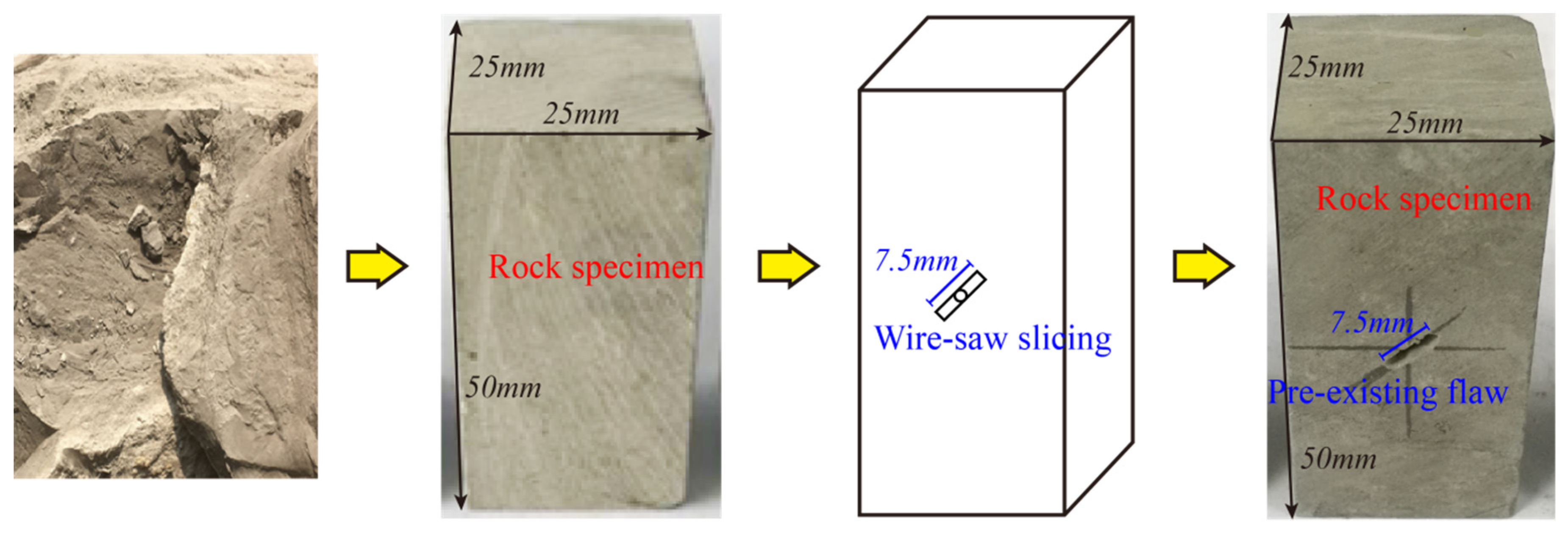
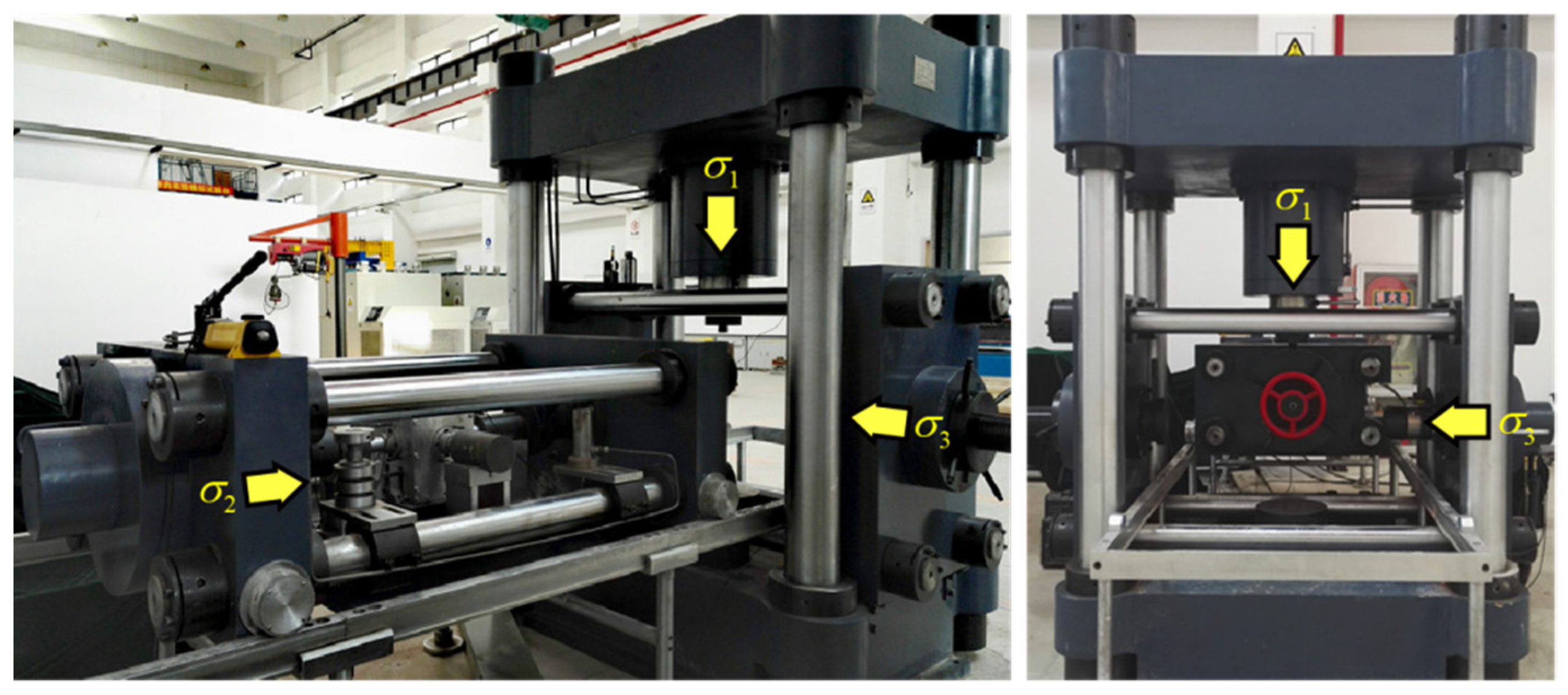
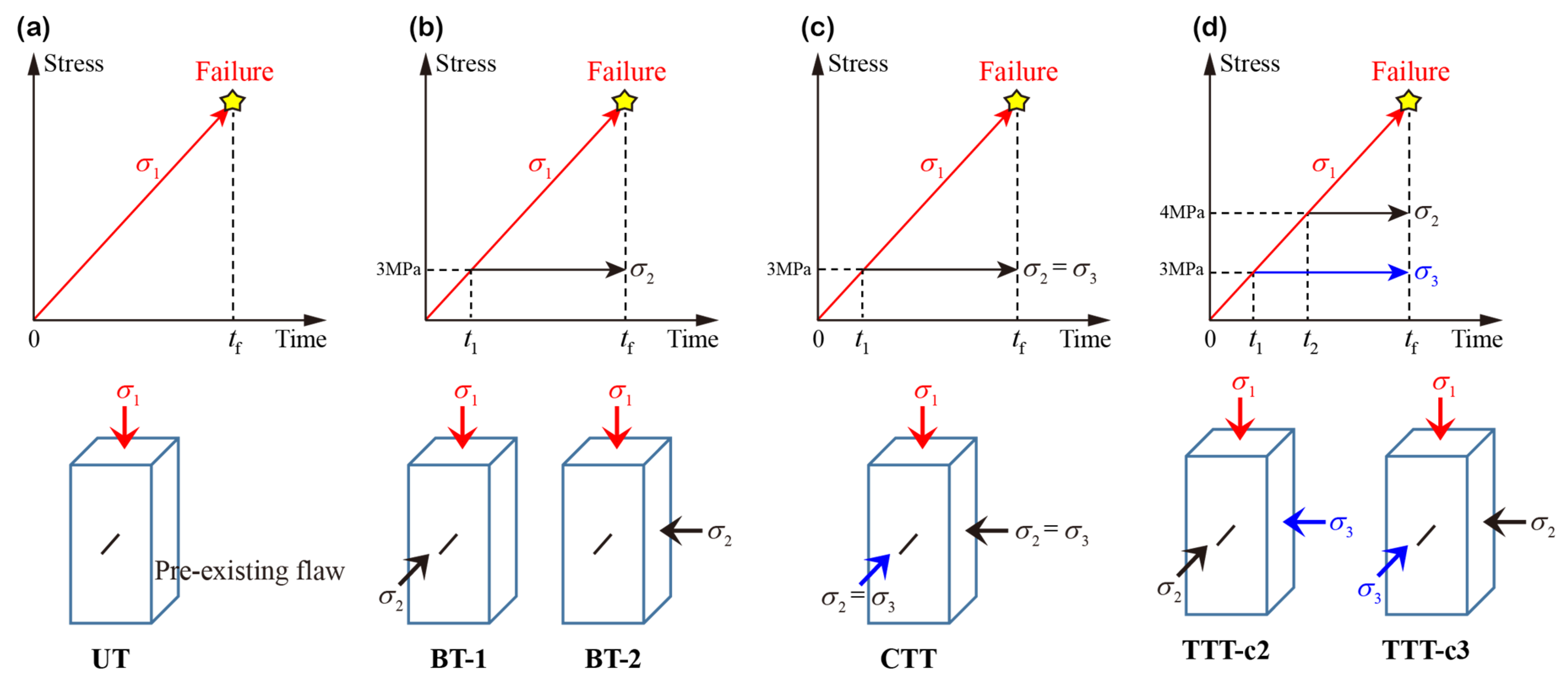
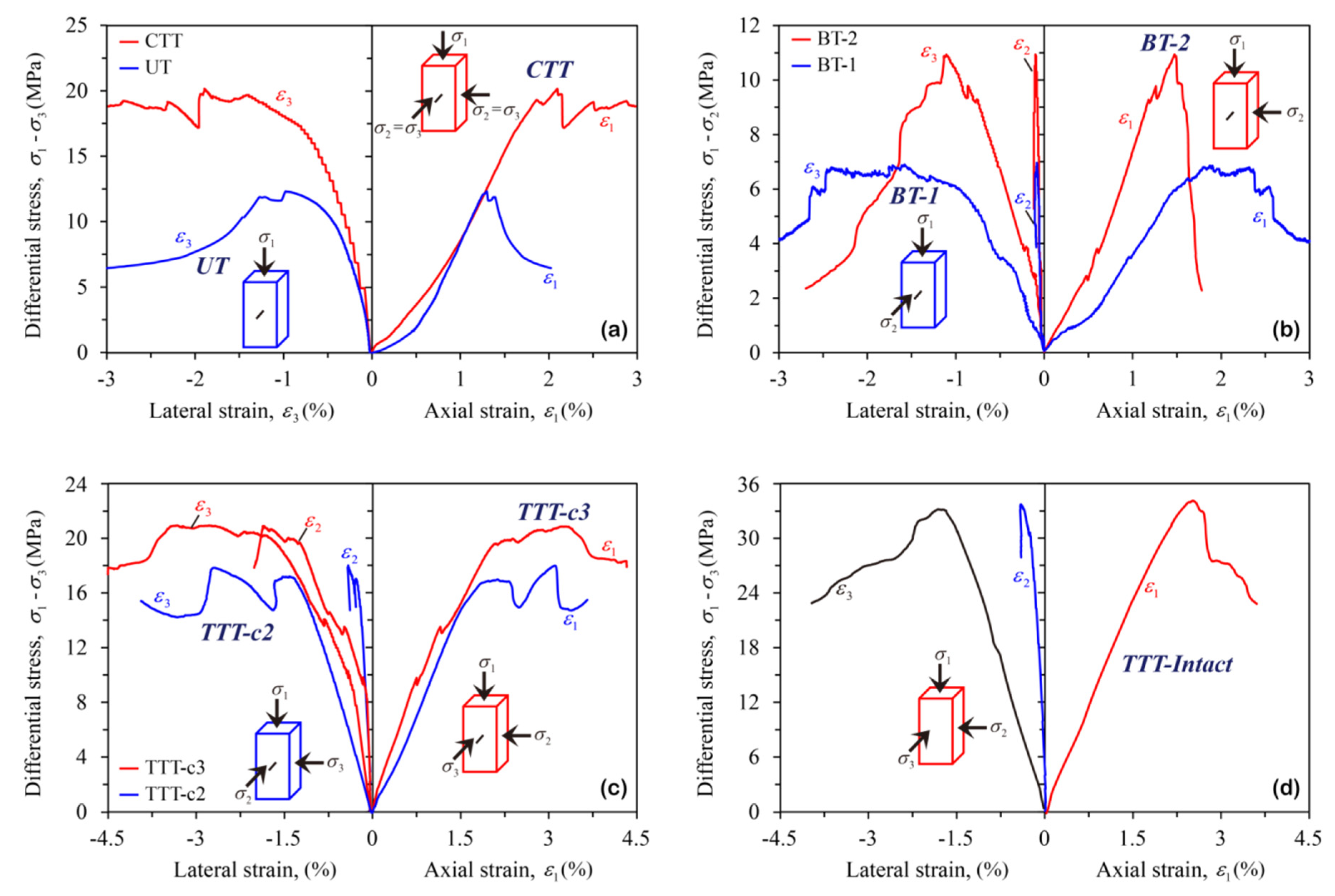


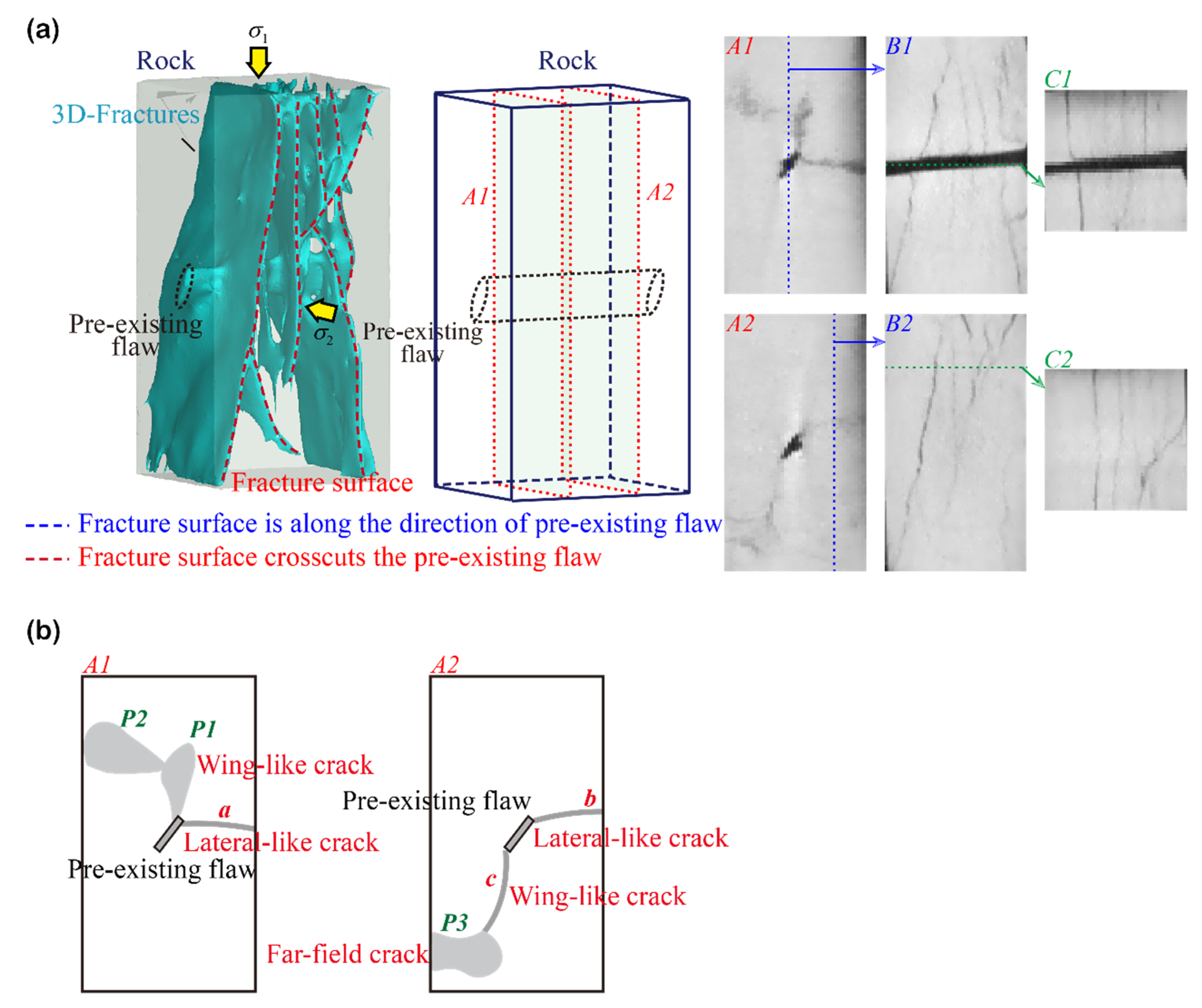
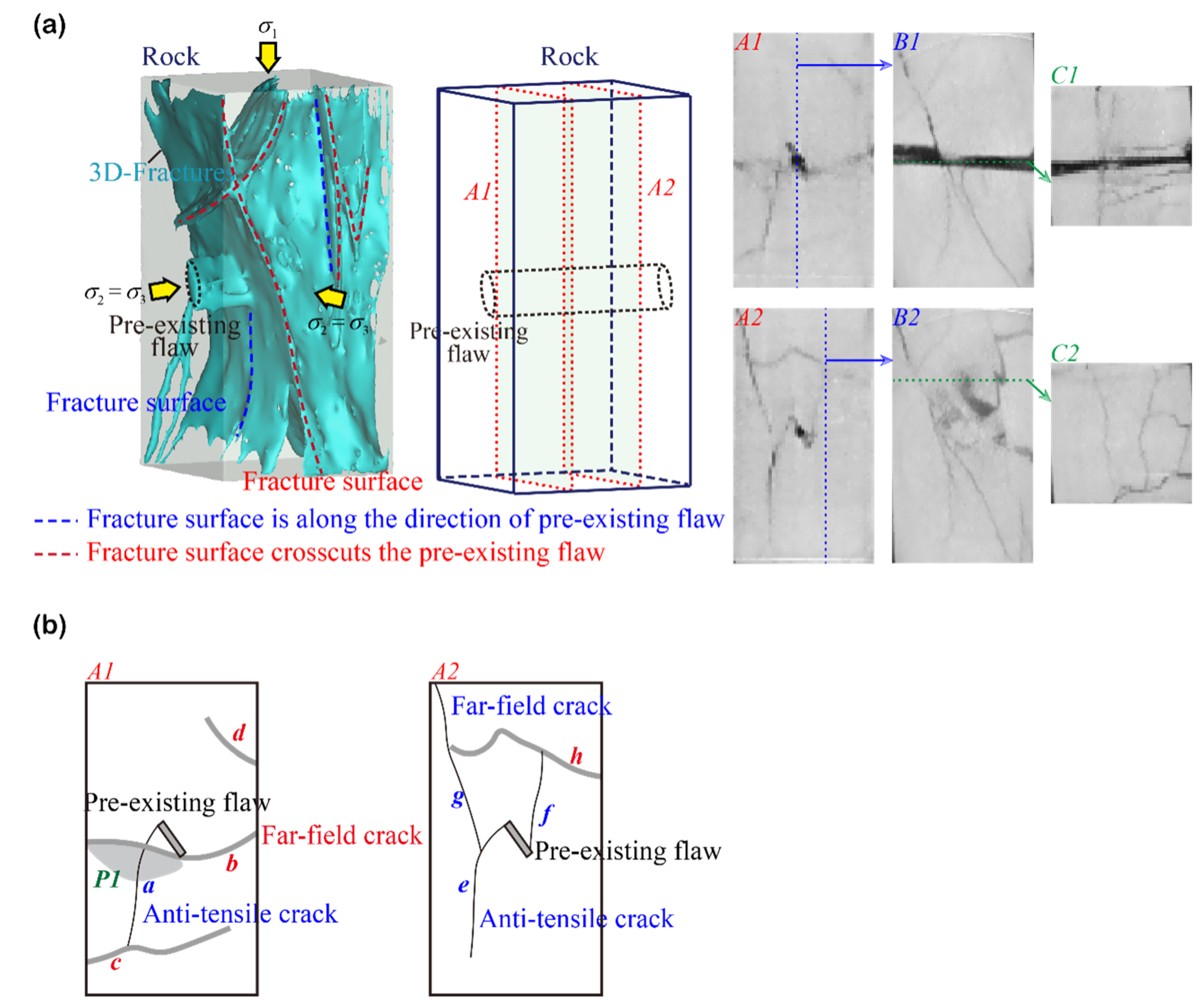
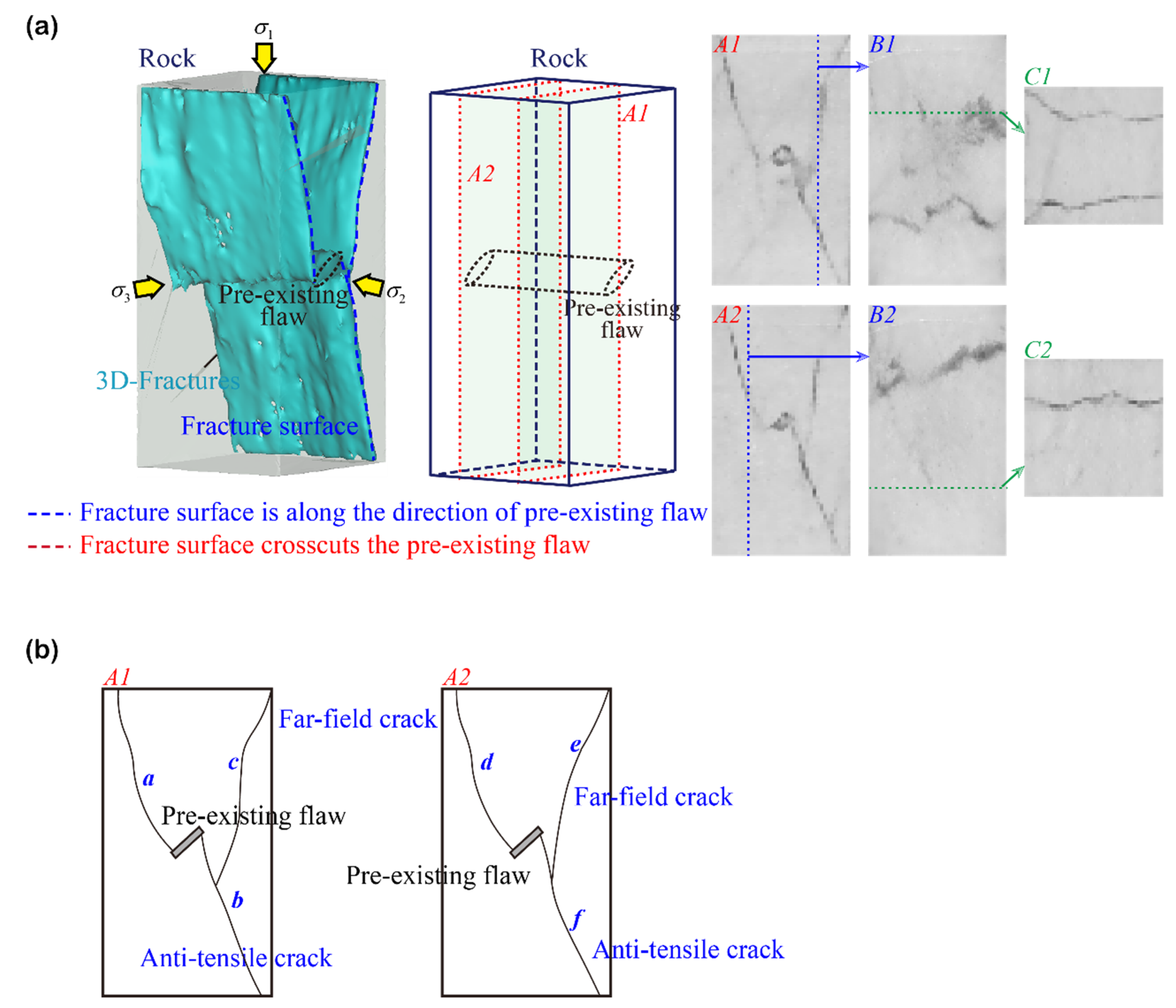
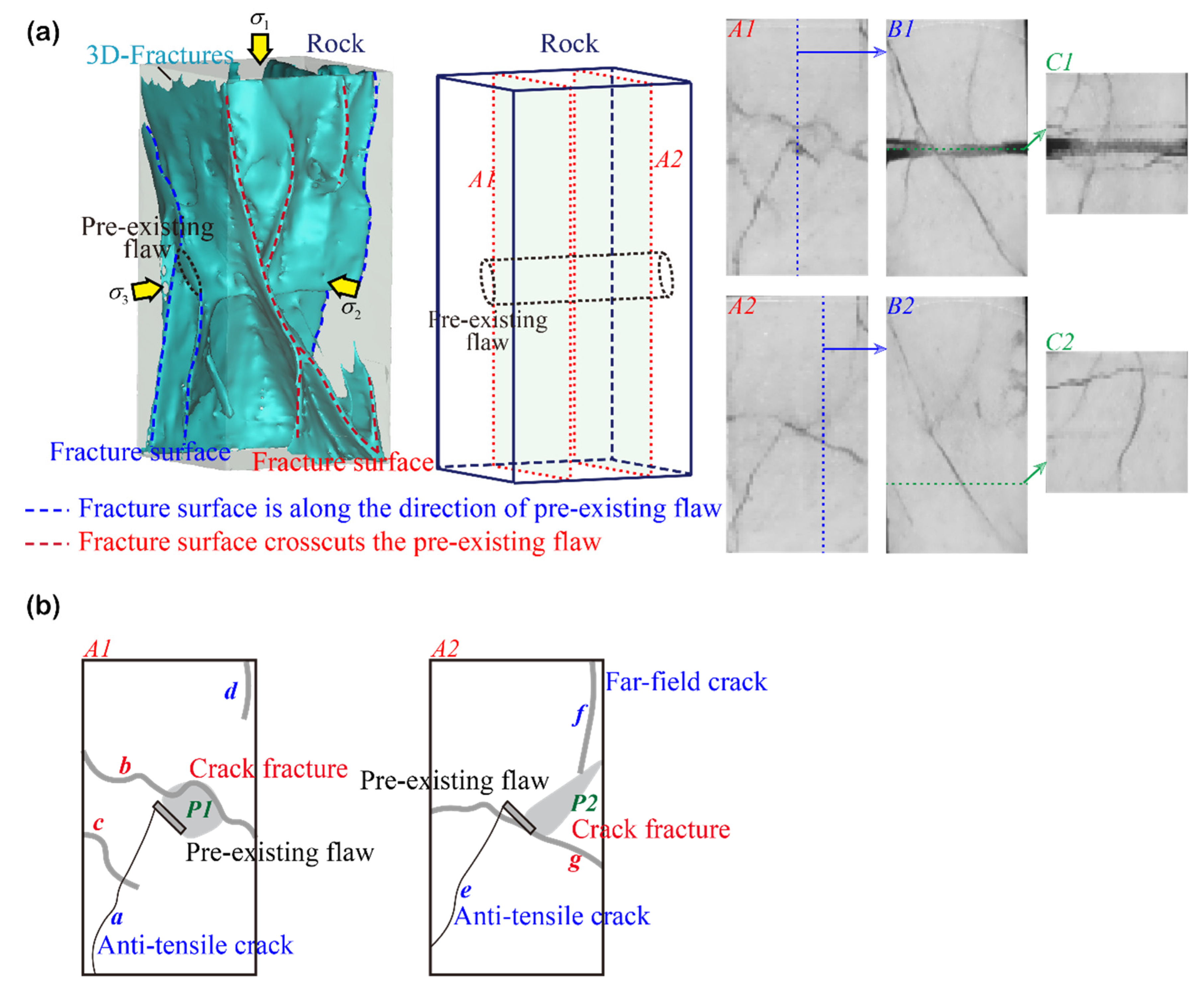

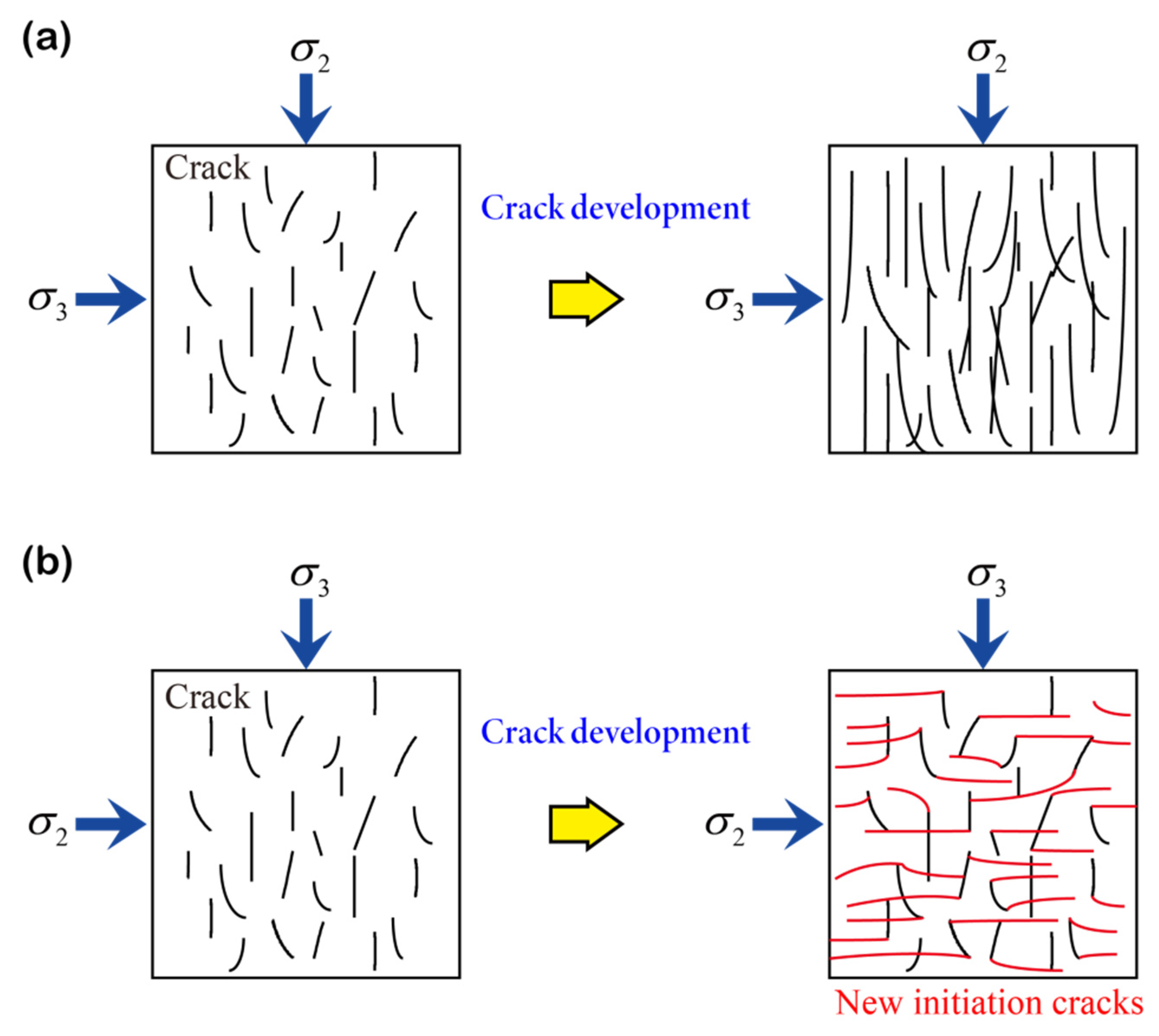
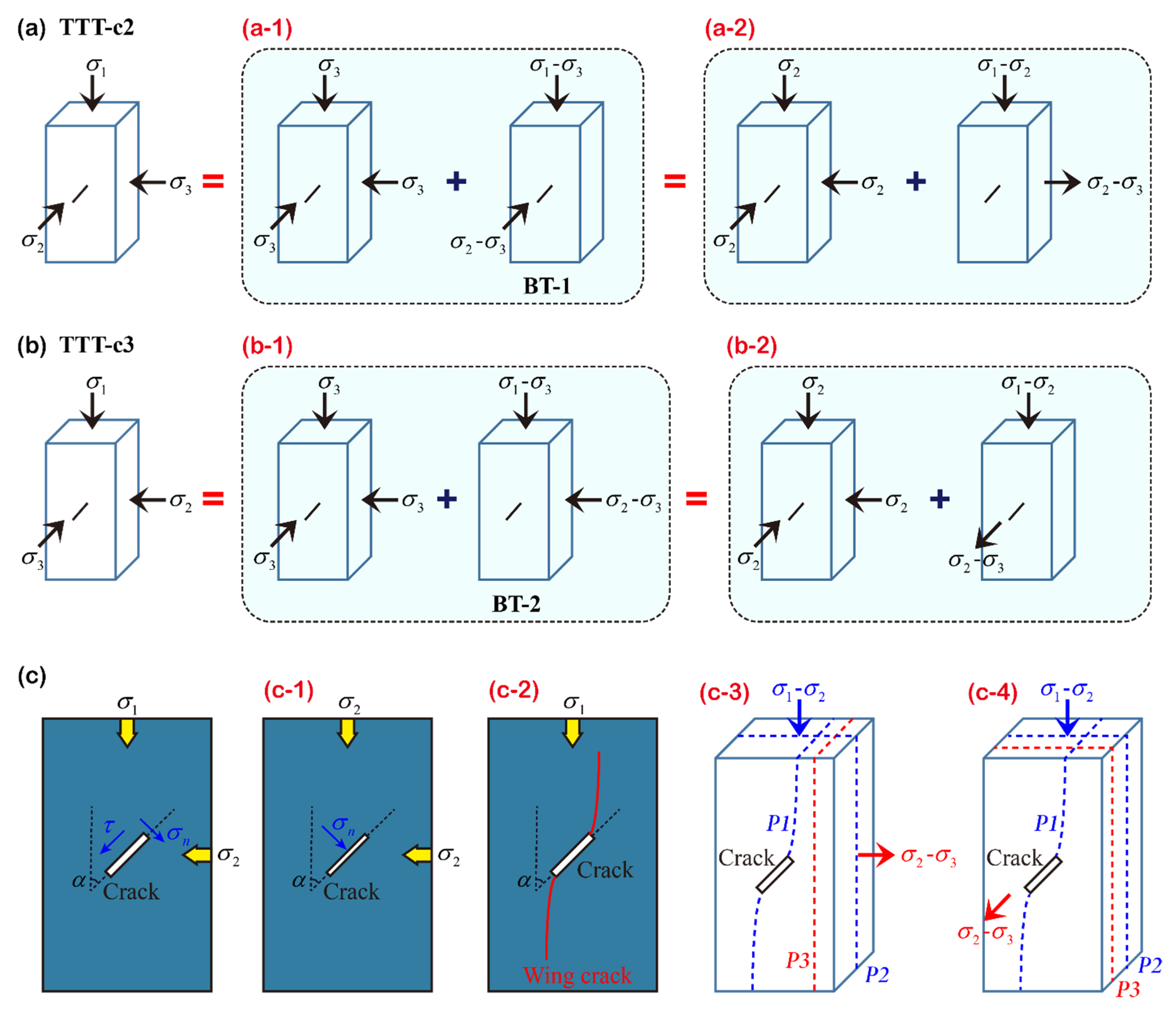
| Test No. | Test Groups | Loading Conditions | Loading Rate (mm/s) | |
|---|---|---|---|---|
| σ3 (MPa) | σ2 (MPa) | |||
| UT | Uniaxial test | 0 | 0 | 0.002 |
| BT-1 | Biaxial test | 0 | 3.0 | |
| BT-2 | ||||
| CTT | Conventional triaxial test | 3.0 | 3.0 | |
| TTT-c2 | True triaxial test | 3.0 | 4.0 | |
| TTT-c3 | ||||
| TTT-Intact | True triaxial test | 3.0 | 4.0 | 0.002 |
Publisher’s Note: MDPI stays neutral with regard to jurisdictional claims in published maps and institutional affiliations. |
© 2022 by the authors. Licensee MDPI, Basel, Switzerland. This article is an open access article distributed under the terms and conditions of the Creative Commons Attribution (CC BY) license (https://creativecommons.org/licenses/by/4.0/).
Share and Cite
Li, Z.; Wang, L.; Li, W. Mechanical Behavior and Fracture Characteristics of Rock with Prefabricated Crack under Different Triaxial Stress Conditions. Minerals 2022, 12, 673. https://doi.org/10.3390/min12060673
Li Z, Wang L, Li W. Mechanical Behavior and Fracture Characteristics of Rock with Prefabricated Crack under Different Triaxial Stress Conditions. Minerals. 2022; 12(6):673. https://doi.org/10.3390/min12060673
Chicago/Turabian StyleLi, Zhaolin, Lianguo Wang, and Wenshuai Li. 2022. "Mechanical Behavior and Fracture Characteristics of Rock with Prefabricated Crack under Different Triaxial Stress Conditions" Minerals 12, no. 6: 673. https://doi.org/10.3390/min12060673






